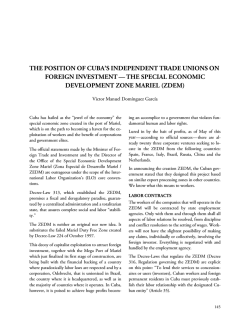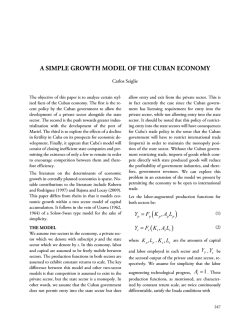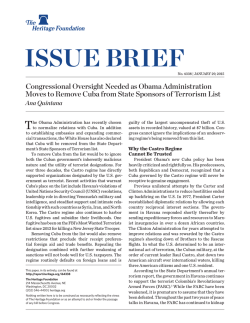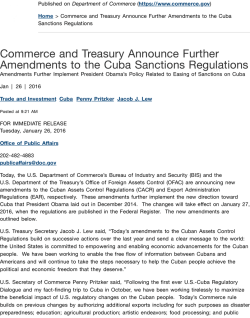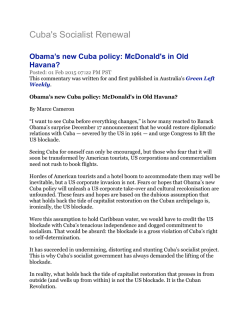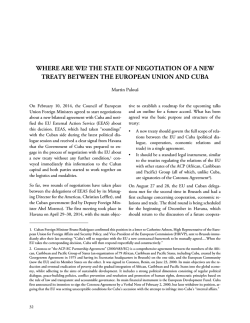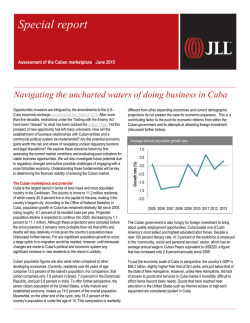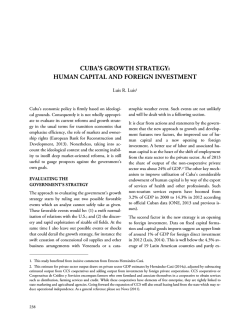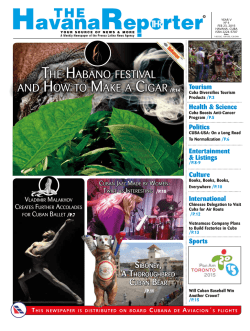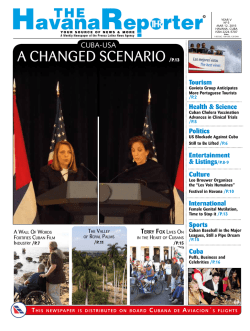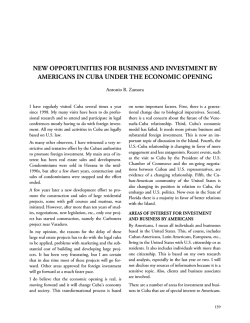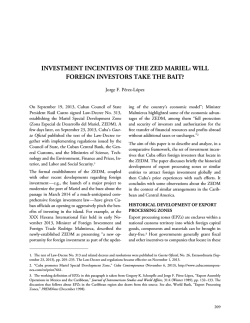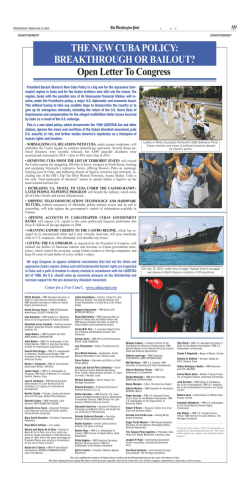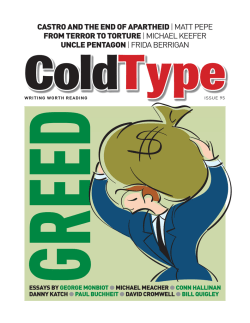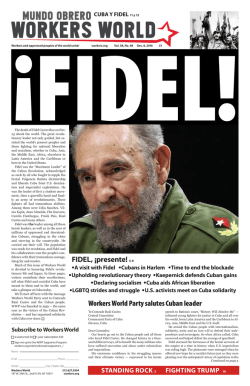
Jorge Perez-Lopez - Association for the Study of the Cuban Economy
CUBA’S PERPLEXING CHANGES: IS THE SOCIETY IN CRISIS? Joaquín P. Pujol The purpose of this paper is to review the main economic problems faced by Cuba and the performance of the Cuban economy in light of the policies adopted by the administration of Raúl Castro since he took over from his brother. Raúl Castro has headed the Cuban government now for six years and it is appropriate to take stock of the results achieved by his economic and development policies during this period. The main economic problems faced by the current Cuban Administration are: • • • • • • • Need to import 80% of the country’s food requirements; Heavily dependent on imported energy; Overgrown and inefficient public sector; Low productivity and lack of appropriate incentives; Lack of necessary financial resources to meet existing requirements for investment; Limited access to external credits because of a poor track record of meeting foreign obligations; Need to implement substantial structural reforms to improve economic performance. The main policy areas focused on by Raul Castro’s Administration are: • • Liberalizing agricultural activities to increase domestic food production and decrease imports; Seeking to improve workers’ productivity by reducing redundant labor in the public sector and tying individual wages to individual’s productivity; • • • • • • Allowing some limited private activities, in the form of “self-employment” (cuentapropistas) for small entrepreneurs and cooperatives; Removing some excessive prohibitions; Revising tax policies; Allowing some private activities access to credit for business and other purposes; Trying to address the shortages of housing, transportation and infrastructure; Resolving problem of external payments arrears and strengthening the balance of payments, including by: • engaging in significant efforts to find oil in Cuban waters; • lobbying to lift the US embargo; • generating foreign exchange through the export of indentured labor; • liberalizing agricultural activities to increase food production and decrease imports. LIBERALIZING AGRICULTURAL ACTIVITIES TO INCREASE FOOD PRODUCTION AND DECREASE IMPORTS Actions taken by the government: 1. Giving individual farmers small plots of land in usufruct; 2. Allowing establishment of agricultural cooperatives; 3. Allowing farmers some access to banking credits. Problems with actions taken: 1. Farmers still have to sell a good part of their crops to the Procurement State Agency Acopio at 1 Cuba in Transition • ASCE 2014 2. 3. 4. 5. 6. 7. prices that do not reflect market conditions and payments are often late; Supply of fertilizers, pesticides, tools, fuel and farming equipment provided by the government monopoly is scarce; Bureaucratic corruption in assigning land, credits and availability of agricultural inputs is widespread; Land made available is infested with marabú; Marketing and distribution system is marred by arbitrary bureaucratic controls and mismanagement. Thefts are prevalent; Lack of capacity for the industrial processing of agricultural products, due to obsolete equipment; Government ministries are reluctant to let go of their businesses and allow cooperatives to replace them; 8. The amounts of bank financing have been minimal. Results: 1. Agricultural production remains relatively stagnant and food imports are projected at US$2 billion for 2014; 2. Over one million hectares of arable land remain uncultivated (about 16% of total land available for cultivation); 3. A significant portion of crops is lost to spoilage and theft due to the cumbersome marketing organization, and to the fact that sale prices cannot be adjusted by the merchants to meet demand due to price controls; 4. Sugar production reached only 1.6 million tons in 2013–2014, less than a quarter of the size of historic crops; coffee production only amounted to 6,105 tons (one tenth the level produced in 1958); the cattle herd is one-half of its size in 1958; milk production declined last year, and so did the production of meat, potatoes, citrus and a number of other fruits. Before the revolutionary government came to power, Cuba was an exporter of sugar, coffee, meat, vegetables and fruits. Currently there is a persistent scarcity of basic products such as milk, coffee, beans, and beer. 2 SEEKING TO IMPROVE WORKERS’ PRODUCTIVITY How? By reducing redundant labor in the public sector and tying individual wages to individual’s productivity. Actions taken by the government: 1. Announced retrenchment of some one million (25%) unproductive workers from the public sector in 2011; 2. Also announced that differential wage scales would be implemented taking into consideration the productivity of workers. Previously all workers received practically the same pay regardless of their productivity; 3. A large number of publicly managed enterprises and government agencies were to be closed, merged or turned over to cooperatives; 4. Steps were taken to improve the accounting practices and management control of public enterprises, and to subject some of them to the payment of taxes. Problems with actions taken: 1. The implementation of retrenchment in the public sector has proved to be difficult to implement because of resistance from the bureaucracy; 2. Equally difficult has been the implementation of different wage scales according to productivity; 3. Productivity gains are not easily achieved with about 3,000 problematic state-run companies; 4. True productivity and profitability of enterprises is difficult to monitor because cost and prices are distorted by the existence of multiple currency exchange rates and the dual domestic currency system; 5. The public sector and service industries are, for the most part, operating with machinery, tools and other supplies dating back to the Soviet era, or even pre-1959 — they are obsolete/incapable of meeting production and financial goals; 6. State-run companies are the number one source of losses and defaults, causing deficits and disruptions in their relations with other state companies and the national banking system. Some 941 of them have been identified as “highly vulnerable” due to corruption. Cuba’s Perplexing Changes: Is the Society in Crisis? Results: 1. While there has been some significant reduction of employment in the public sector, the original timetable for retrenchment has been pretty much abandoned; 2. Steps were recently taken to improve the salaries of medical personnel and athletes, but most salaries are very low and do not provide incentives to workers; 3. Productivity gains in public sector enterprises have been limited so far to some 1,000 companies, most of which are associated with foreign investors; 4. There is still a huge problem with nearly 3,000 state companies, accounting for two-thirds of the economy and some 2 million workers. These companies were not profitable in the 1960s, in the 1980s, and are not profitable today; 5. It should be noted that ending the dual currency system is not just an issue of establishing a new financial mechanism. Without tackling the problem of the dysfunctional state companies, the financial mechanisms remain vulnerable. This is the true “black hole” of the Cuban economy. It is not just a monetary issue, it is a serious structural problem. ALLOWING SOME PRIVATE LIMITED PRIVATE ACTIVITIES IN THE FORM OF “SELF-EMPLOYMENT,” SMALL ENTREPRENEURS, AND COOPERATIVES Actions taken: 1. A specific list of 187 activities have been identified as eligible for “self-employment.” Mostly services and menial activities; 2. The new measures allow individuals to legalize activities that may have been conducted previously in the black market. But to do so they must register with the Government, pay a license fee and become subject to taxation; 3. Some types of privately-organized cooperatives have been authorized. Problems with actions taken: 1. No professional or technical private activities have been authorized for self-employment. The 2. 3. 4. 5. 6. 7. number of activities authorized is small and any activity not specifically listed is prohibited; While the number of persons registered as selfemployed has risen from about 100,000 to 467,000 (out of a 6 million workforce), few are former public sector employees who were retrenched. The majority are individuals that were not officially employed or retirees; A very heavy taxation and regulation have been imposed on these activities, often established in an arbitrary and bureaucratic manner; Some cuentapropistas (self-employed) have turned in their licenses as they found their operations not to be profitable or felt harassed by the authorities; Small and mid-sized companies, both privately owned and cooperatives, have been excluded from interacting with foreign investors and prevented from engaging in direct imports and exports; The government has revoked the licenses for certain activities because they were becoming too competitive with the state-run stores; The government has established a new set of custom duties, taxes and restrictions on the importation of goods to be sold or utilized by these new businesses. Results: 1. In general, the development of these private activities have been positive for the availability of goods and services to the population at large; 2. Some 13,000 new privately-run businesses have been established (a high percentage selling food); 3. Private activity is the most dynamic sector of the Cuban economy but its weight within total output and employment is still very small; 4. There are still a lot of problems facing private activities because of the difficulties of obtaining the necessary inputs and the harassment that entrepreneurs are subjected to by the authorities. REMOVING SOME EXCESSIVE PROHIBITIONS Actions taken: 1. Authorizing the sale of computers, printers, cellular telephones, and other hardware in the 3 Cuba in Transition • ASCE 2014 2. 3. 4. 5. 6. State-run dollar operated stores, and some limited access to the Internet; Authorizing Cuban nationals access and ability to lodge in tourist hotels, tourist facilities and beaches under certain conditions; Authorizing Cuban nationals to rent rooms and/ or houses to tourists; Approval of private sales and purchases of cars, real state, and other goods; Comprehensive migration reform. Allows many Cubans to travel abroad for a limited time without having their properties expropriated;1 Enacting a new foreign investment law and other legislation that facilitates new foreign investments Problems with actions taken: 1. There are still significant limitations to the ownership and use of computers, cell phones and access to the Internet; 2. Cost of Internet access and cellular telephone calls charged by the State monopoly is still way above international prices and out the budget of most Cubans. Moreover the service is slow and poor; 3. Staying at tourist hotels is very expensive for Cubans and access to some beaches and hotels is still restricted; 4. Hiring for tourist hotels is channeled through a government-run company. Generally, blacks are not hired for tourism jobs; 5. Individuals renting rooms or houses need a license and pay heavy taxes that are due whether the property is rented or vacant; 6. Only 50 automobiles and four motorcycles have been sold during the six months since the new law that authorized islanders to buy such vehicles from the state-run dealerships was enacted. The prices are way above the purchasing power of most of the population and international prices; 7. Other limitations and prohibitions continue to hamper economic activity, such as the prohibition for direct imports and exports by private individuals and firms, the prohibition for individuals to engage in private professional activities (such as engineering, medical, legal, accounting, architecture, banking services and even teaching); and a number of other areas controlled directly by the State. Results: While a number of prohibitions have been lifted, in general the economic system is still very restrictive and anything that is not specifically authorized is prohibited or illegal. REVISING TAX POLICIES Actions Taken: Tax legislation was revised, adding new taxes on selfemployment activities, and a new foreign investment law was recently enacted. Problems with actions taken: 1. Some of the provisions of the new legislation are significantly more onerous on domestic citizens as compared with the treatment given to foreign investors or public sector firms; 2. The new Foreign Investment Law may violate a number of international treaties to which Cuba is a party; 3. In December 2013, more than 50% of the public sector firms failed to file a tax declaration; most companies in Cuba are not accustomed to filing tax returns and do not have appropriate accounting systems; 4. The courts are not independent from the government and the legal system is subject to subjective and arbitrary interpretation. Results: Cuban tax policy merits an extensive discussion. Some has taken place in various sessions of the cur- 1. The subject of migration policy merits a separate discussion because of the complexities involved. A paper on that subject was presented in 2013 at ASCE’s Annual Conference by Laritza Diversent. See Laritza Diversent, “Cambios en la Política Migratoria del Gobierno Cubano: ¿Nuevas Reformas?,” Cuba in Transition — Volume 23 (Washington: Association for the Study of the Cuban Economy, 2013). 4 Cuba’s Perplexing Changes: Is the Society in Crisis? rent ASCE 24th Conference, with emphasis on the new Law 113 concerning domestic taxes and on the new Foreign Investment Law. But because little time has elapsed since the new two laws were adopted there is little experience with their implementation at this time. ALLOWING SOME PRIVATE ACTIVITIES ACCESS TO CREDIT FOR BUSINESS AND OTHER PURPOSES Actions taken: 1. Government banks are now authorized to give some credits to farmers, self-employment activities and individuals (mostly for housing repairs), but the amounts involved have been very limited; 2. Microfinance and bank credit have begun to reach some small businesses, private farmers, and urban and agricultural cooperatives, but the reach — less than $100 million for some 300,000 customers — is modest, and most go to non-productive purposes (home construction and improvements, and some services). 2. Banks in Cuba have acted in the past more like appendices of the Central Government’s Treasury Department in distributing the funds that have been allocated by the Cabinet to various purposes. They are not accustomed to measure risks of repayment and bankers have a bureaucratic mentality. This will have to be radically changed for the banks to act as true banks and credit to be assigned according to appropriate criteria. TRYING TO ADDRESS THE SHORTAGES OF HOUSING, TRANSPORTATION AND INFRASTRUCTURE Actions taken: 1. There is an absence of a financial mechanism to finance mortgages, and the loans that have been made available to finance home repairs and remodeling are completely inadequate. There is a need for a major reform in the legislation and in the bureaucratic practices of the banking system to provide adequate results; 2. While the government has authorized some small loans to finance home repairs, there is still a big problem in obtaining the necessary construction materials; 3. Foreign banks are not allowed to operate in Cuba and private lending activities are not formally authorized. 1. The government continues to build housing for high-level army officers and apartment units for soldiers in the periphery of Havana and in areas where military personnel are stationed; 2. Concerning government-constructed housing for the general population, actual completions have fallen significantly below levels planned and the current shortfall is estimated at over one million units; 3. The government has now authorized private individuals to build and repairs their own homes, and has made available some small banking credits for this purpose; 4. The government has now authorized private sales of houses; 5. The government has purchased a new fleet of buses from China and has been negotiating with Chinese companies about establishing an assembly plant in Cuba; 6. The government is just completing a transshipment mega-port at Mariel; financed by Brazilian loans; 7. As part of the above port project, the government has just completed a 65 km railway link between Havana and the new port of Mariel. Results: Problems with actions taken: 1. The credit market for private activities is practically non-existent and a legal and administrative framework will have to be created before banking and credit operations can make a substantive contribution to the growth of the economy; 1. Many Cubans live in houses that are in very poor condition, with caved-in roofs, peeling paint, broken down fixtures and doors barely hanging from their hinges, and they have no financial resources available to fix them: Problems with actions taken: 5 Cuba in Transition • ASCE 2014 • 2. 3. 4. 5. 6. 7. 8. 9. 6 Roughly seven out of ten houses need major repairs; • 7% of the housing in Havana has formally been declared uninhabitable; • housing conditions are even worse in the interior of the country; • when financing is available there are no construction materials; what becomes available is likely to be the product of theft (including from damaged buildings). Lack of maintenance over so many years and damage from hurricanes has produced an overwhelming number of houses that need repair; The water supply and sewer infrastructure is at a breaking point and close to catastrophic failure due to: • deterioration of water supply lines; • antiquated and substandard plumbing materials; • inefficient maintenance practices. 58% of the potable water is lost through leakages; The wastewater infrastructure is a serious concern. 59% of 2,160 contaminants recognized by the UNEP are released into Cuba’s environment without treatment. Contaminated water is already having a negative impact on the health of the population and the propagation of epidemics; The island’s roads and bridges are unsafe and in need of repair, but the state lacks the funds for this purpose. This has contributed to the breakdown of imported vehicles. Broken vehicles are not repaired because of the lack of parts, which are often stolen from warehouses; Cuba’s railroad system suffers from multiple infrastructure problems, including rotten ties, rusted rails, and loose tie plates. Railroad bridges are also in precarious condition; With the exception of the mega transshipment port of Mariel, Cuba’s principal ports (Havana, Matanzas, Santiago de Cuba and Cienfuegos) are unable to accommodate large, modern vessels; The centralized electrical grid, which is supposed to serve 95% of the population, is old and expensive to operate. 10. There are seven major power plants that use inefficient equipment from the former Soviet Union and Eastern Communist countries, as well as old American equipment. All plants are operating below estimated capacity level. Results: 1. The authorization of private sale of houses has created an opportunity for encouraging some repairs and remodeling on the part of those involved in such transactions. But this involves a very small portion of the housing stock; 2. Unless private construction companies are allowed to operate and a mortgage finance market is organized, there is little chance for the housing situation to improve significantly in the foreseeable future; 3. The government needs to change the focus of its investment activities to take care of the urgent problems faced by the water supply and other infrastructure problems; 4. The new modern Port of Mariel, just 45 km from Havana, is designed to serve super container ships. However, the possibility of serving as a container transshipment facility to the US is currently not allowed under the US embargo legislation. This port will have major competition from the high-tech port of Miami, the closest US port to the new Panama Canal expansion. RESOLVING EXTERNAL PAYMENTS ARREARS AND STRENGTHENING BALANCE OF PAYMENTS Actions taken: 1. Faced with a significant deterioration in the balance of payments that led to external payments arrears and a freeze of foreign exchange deposits, in 2009 the Government undertook a very sharp reduction in public sector expenditures, instituting a 6% across the board budget cut in all public sector agencies and enterprises. The cutback in expenditures involved all types of imports, but especially oil, which is a big item in Cuba’s import bill; 2. This was followed by the announcement of a proposed 25% retrenchment of public sector employment; Cuba’s Perplexing Changes: Is the Society in Crisis? 3. There was an intensification of efforts to find oil deposits in Cuban waters. A large number of companies from different countries were encouraged to explore for oil in Cuban waters; 4. The Cuban Government has approached a number of creditor countries that held Cuban debt to seek a bilateral renegotiation of those obligations, so as to reestablish the possibility to obtain new credits; 5. The government has sought out investments from friendly counties, such as Brazil, Venezuela, Russia and China; 6. There is an active lobbying campaign in the United States to seek a lifting of the US embargo; 7. Intensification of the practice of sending Cuban medical personnel and others as indentured labor to serve in other countries. Problems with actions taken: 1. The deep budget cuts implemented, while helping improve the balance of payments, not only affected some planned investments but also the availability of crucial supplies and inputs for some activities. This contributed to reduced output (this was particularly the case in agriculture); 2. The reduction in the work force negatively affected workers’ morale and probably encouraged more pilfering of public sector goods and supplies; 3. The budget cuts also reduced significantly the food and other subsidies provided by the government as well as the provision of healthcare and educational services to the population; 4. While several different foreign companies have engaged in oil exploration in Cuban waters, so far no significant amounts of oil have been found to justify commercial operation. Cuba is still heavily dependent on Venezuela for its oil supplies; 5. While some foreign companies have invested in Cuba, there have been problems with corruption and the number of foreign companies with investment, which had exceeded 400 at one point, is now down to about less than half that number. Results: 1. There has been a significant strengthening of the balance of payments in the last two years, and Cuba has been able to pay back the arrears, liberate frozen deposits, and renegotiate some of its foreign debt; 2. Despite the Brazilians taking over the management of at least one of the sugar mills, sugar production has not increased significantly and Cuba has to import some sugar; 3. While the practice of sending medical personnel and other professionals abroad as indentured labor has brought a very substantial flow of foreign exchange to the Cuban government, it has resulted in shortages in the availability of these services to the Cubans in the island; 4. So far no commercially-viable oil deposits have been found in Cuban waters, despite the efforts made by several foreign companies, and Cuba is still highly dependent on Venezuelan oil. Also Cuba still needs to import most of its food consumption; 5. The Cuban government estimates that it needs some $2.5 billion of foreign investment per annum in order for the economy to achieve sustainable growth. CONCLUSIONS While progress has been made with some policy initiatives to cope with the multitude of problems faced by the Cuban economy, the overall results are far from a satisfactory solution to the problems encountered. The positive impact of some of the policies announced are undercut by other actions taken to control their implementation, leaving observers perplexed as to the true intentions of the authorities. 1. The economic policies implemented by Raúl Castro’s administration, as outlined under the “Lineamientos” adopted by the National Assembly, have not yielded the expected results, and the Cuban economy is not experiencing a resurgence of economic growth. Cuban authorities have recently downgraded their already weak growth forecast for 2014. 2. While the reduction of the fiscal deficit has resulted in an improvement in the overall balance of payments, this has been obtained through a 7 Cuba in Transition • ASCE 2014 3. 4. 5. 6. 8 reduction in the importation of some needed inputs and postponement of crucial investments, particularly in infrastructure. Moreover, there has been a significant reduction in social expenditures, cutting back the resources available for education, health and social welfare. The measures taken to lift prohibitions of certain activities have been welcomed by the population, but their implementation in some cases has been marred by bureaucratic interference and leaves one puzzled as to the real intentions of the authorities. Many of the policy measures adopted so far seem merely palliative, aimed at coping with possible social unrest, and their impact is neutralized by arbitrary controls and very heavy taxes and license fees. The country continues to be snared by a political and institutional system that wants the government to keep a tight control of everything, ignoring human rights and leaving aside political freedom, private property, a market economy, and a legal framework that can be trusted. Not enough has been done to address the problems of transportation, marketing and distribution of food, the deterioration in the educational and health systems, the high cost and poor quality of products sold and the services provided by State-run companies, the widespread corruption of public officials at every level, the bias in implementation of legal procedures by the courts, and the poor operation of the banking system with respect to collections and payments. Moreover, the continued presence of multiple currency practices gives rise to hidden cross-sub- sidies that tend to favor the profitability of some activities and penalize others. The policy of gradual dismantling of the system gives rise to opportunities for speculation and further complicates the determination of which activities are really profitable and which are losing propositions that should be terminated. 7. The government is once again appealing to foreign investors to come to help undertake investments that might contribute to generate economic growth. But private international capital is unlikely to be attracted given the political, economic and legal uncertainties prevailing in Cuba under the current administration. So Cuba has to rely on political allies that have their own political agenda and demand a political price, or on speculators that are after incentives such as tax exemptions and the availability of cheap labor. As has been shown in the past, these are not dependable or honest partners for the long run. 8. The continuous exodus of the young, their refusal to procreate while living in the island, the growing presence of prostitution and acceptance of thefts as a normal behavior in order to resolver (survive), are growing signs of an a society in crisis. 9. Very substantial structural economic, political and social reforms are needed to change the growth performance of the Cuban economy. I am sorry to say that under current circumstances, I am very doubtful that Cuba will achieve sustainable growth in the near future.
© Copyright 2025
